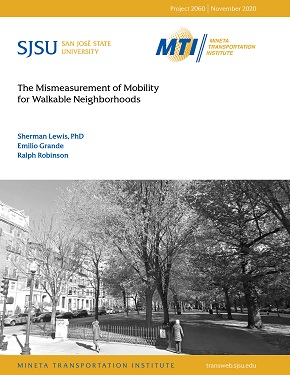- 408-924-7560
- mineta-institute@sjsu.edu
- Donate
The Mismeasurement of Mobility for Walkable Neighborhoods
The major US household travel surveys do not ask the right questions to understand mobility in Walkable Neighborhoods. Yet few subjects can be more important for sustainability and real economic growth based on all things of value, including sustainability, affordability, and quality of life. Walkable Neighborhoods are a system of land use, transportation, and transportation pricing. They are areas with attractive walking distances of residential and local business land uses of sufficient density to support enough business and transit, with mobility comparable to suburbia and without owning an auto.
Mobility is defined as the travel time typically spent to reach destinations outside the home, not trips among other destinations that are not related to the home base. A home round trip returns home the same day, a way of defining routine trips based on the home location.
Trip times and purposes, taken together, constitute travel time budgets and add up to total travel time in the course of a day. Furthermore, for Walkable Neighborhoods, the analysis focuses on the trips most important for daily mobility.
Mismeasurement consists of including trips that are not real trips to destinations outside the home, totaling 48 percent of trips. It includes purposes that are not short trips functional for walk times and mixing of different trips into single purposes, resulting in even less useful data. The surveys do not separate home round trips from other major trip types such as work round trips and overnight trips.
The major household surveys collect vast amounts of information without insight into the data needed for neighborhood sustainability. The methodology of statistics gets in the way of using statistics for the deeper insights we need. Household travel surveys need to be reframed to provide the information needed to understand and improve Walkable Neighborhoods. This research makes progress on the issue, but mismeasurement prevents a better understanding of the issue.
Sherman Lewis
Sherman Lewis is a retired professor of political science at California State University East Bay, Hayward. He specialized in citizen policy and in environmental politics and leads a small advocacy group, the Hayward Area Planning Association. He was a leader in the California Sierra Club and served four years on the BART Board.
Emilio Grande
Emilio Grande graduated from California State University East Bay, Hayward and is pursuing graduate studies in hydrogeology.
Ralph Robinson
Ralph Robinson is a student in the Master of Urban Planning program at San Jose State University and a research assistant with the Mineta Transportation Institute.
-
Contact Us
San José State University One Washington Square, San Jose, CA 95192 Phone: 408-924-7560 Email: mineta-institute@sjsu.edu






